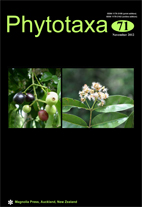Abstract
Chaunostoma Donnell Smith (1895: 9) and Lepechinia Willdenow (1804: 20, pl. 21) belong to the subtribe Salviinae of the Lamiaceae (Harley et al. 2004). Chaunostoma is known as a monotypic genus and is restricted to South Mexico (Chiapas) and Guatemala. However, the generic delimitation of Chaunostoma has been questioned because of the close relationship with Lepechinia, which includes ca. 40 species and is mainly distributed from Argentina to Mexico and Northern California (Epling 1948). In fact, Chaunostoma differs from Lepechinia only by cauliflorous inflorescences and the arched stamens (Epling 1948, Harley et al. 2004). Nevertheless, since the arched stamens can also be found in Lepechinia (Epling 1948, Walker & Sytsma 2007), the generic status of Chaunostoma has become increasingly problematic within Salviinae. Following a recent phylogenetic study, Chaunostoma and Lepechinia are considered together as a monophyletic group within Salviinae (Drew & Sytsma 2011). The micromorphological characteristics of these two genera support the same conclusions as the molecular phylogeny. For example, Chaunostoma and Lepechinia produce perforate pollen grains while the other members of Salviinae possess bireticulate pollen grains (Moon et al. 2008). Moreover the areolate abscission scar of the nutlets is a synapomorphic condition for Chaunostoma and Lepechinia (Moon et al. 2009). Therefore, the new synonym and the necessary combination are proposed here.

